Article: Joyce Wilkie (Canberra Organic – Winter 2001)
The following article is from the notes of a talk that Joyce presented to COGS in 1988. It has been reprinted to provide an example of how you can plan your own vegetable growing.
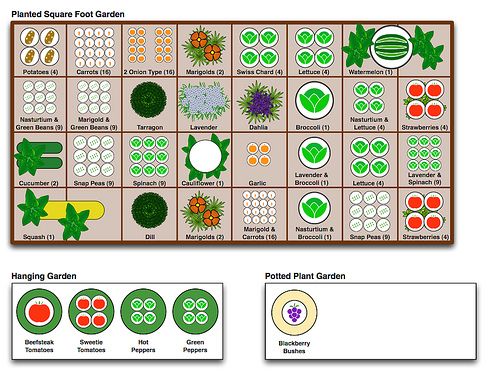
‘Square Foot Gardening’ is a name coined by Mel Bartholomew to describe an intensive, highly methodical form of gardening that he has promoted both on public television in the United States and in two books that he has written (see references). There is nothing radically new in any of his gardening procedures. What is different from conventional methods is his emphasis on continuous cropping of small plots of ground. What is offered is a very detailed and logical method for producing either:
- a continuous supply of a wide variety of vegetables to feed a family (Figure 1); or
- a steady supply of several varieties of vegetables that can be sold to provide a small cash income.
By using square foot methods it is possible to avoid both the late summer glut of vegetables and the winter shortage, experienced by many gardeners. In the following article I will outline Bartholomew’s methods. He is not strictly an organic grower, however this does not detract from his method, which can be used in any organic garden.
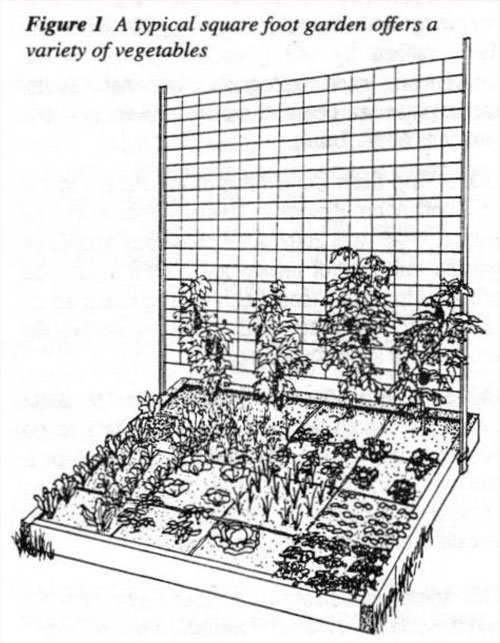
Method
Planning the garden layout
The philosophy that the idea of square foot gardening can be summed up by the following quotation from the book Cash from Square Foot Gardening: ‘Why did we grow so much and why was it all ready to harvest at the same time?.. Were still being taught by most experts to grow crops in long single rows, and now the latest fad is double or triple rows or even wide rows, as if a single row fifteen feet long didn’t produce enough lettuce all at once. What’s a home gardener going to do with thirty heads of leaf lettuce in one week? Now we’re supposed to grow triple rows and raise ninety heads’!!
The square foot method gets right away from planting in rows. Instead as system of rectangular beds is used. The beds are worked only from their edges making it possible to totally fill the growing areas with vegetables. It works out that almost all vegetables can be spaced using a 1-foot square grid. This makes the garden layout and the organisation of plantings very straightforward. In order to keep the beds full and continually productive you need only think about 1 square foot at a time. This is exemplified by radishes (Figure 2) which are planted 16 per square foot. If your family eats, on average 16 radishes in a week then plant out 1 square foot on a weekly basis. Once the radishes start to mature each square foot is simply harvested and immediately resown.

The most efficient garden layout is a system of 4 foot wide beds. The length of the beds and the width of the aisles separating them will depend on your individual requirements regarding efficient use of the space available (Figure 3).

If you’re going to have nine 4’x4′ (16 square feet) planning squares, here’s how aisles of different widths would affect the percentage of your overall garden space devoted to growing:
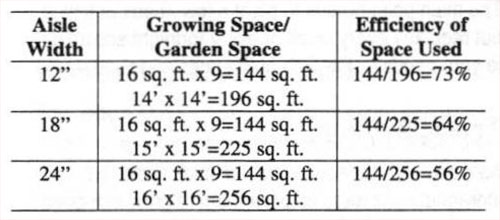
Construction of Beds
Borders
It is important to delineate the beds by bordering them. The recommended method is a system of raised beds surround by wooden sides at least 6 inches high. These can be very simple, however, well built edgings designed to support covering frames are worth the extra effort in a place like Canberra where the growing season is short (see section on Covers).
Soil
Square foot gardening is an intensive method therefore the soil should be the very best possible. Given that the beds are small and contained this is not too difficult to ensure. Initially the existing soil is dug and loosened then the best possible soil is added on top to fill the bed. The perfect soil is filled with humus, which acts as a sponge to hold moisture in the soil, but at the same time allows drainage of any excess water. Peat moss, vermiculite and well-rooted manure are all sources of humus. The texture of the perfect soil is loose, uncompacted, well drained, and friable—it should be full of earthworms. The square foot method recommends buying planting mix as an easy and quick but expensive option. Organic gardeners however favor making such soil by composting and by heavy mulching. My own experience with mulching, and the results of generating soil, using weeds heaps as is done in the COGS community garden, have convinced me that extremely healthy and productive soil can be generated quite quickly and cheaply. With square foot gardening even more emphasis must be placed on the maintaining the fertility of the soil and so continuous composting and recycling of organic waste is an absolute must.
Vertical Plant Support Systems
All vine crops are most efficiently grown vertically on trellises. This not only saves space but allows watering and harvesting. The fruit is kept off the ground and so ripens more evenly and is less susceptible to rotting and attack by pests. These supports have to be strong and the size of the mesh will depend on the crop.

I use 6-inch weldmesh for beans, tomatoes and pumpkins; and chicken wire for peas and cucumbers. I tie the mesh to star pickets, which are strong and are easy to move to different locations (Figure 4). However, it is possible to build frames onto southern sides of your beds if you have strong well-constructed borders (Figure 5).
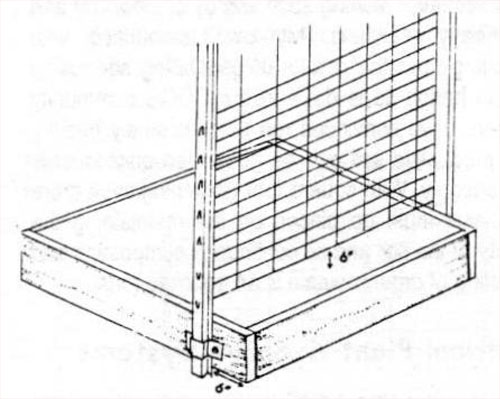
Covers
With a set of beds all four foot wide it is easy to devise a system of hoops or wire tunnels that can be moved around the garden and used to support a cover of either:
- shade cloth to protect young seedlings when newly transplanted or when the temperature is high; or
- plastic to form a mini green house/cloche in early spring and autumn (Figure 6).
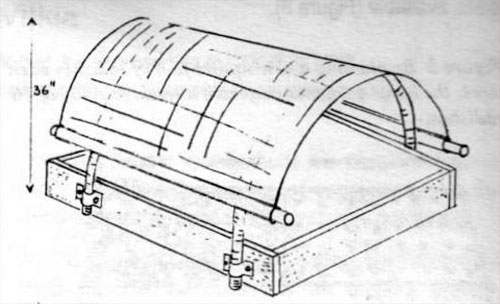
Planting
Plants are divided into four sizes (Figure 7a and 7b):
- Extra large: 1 plant per square foot
- Large: 4 plants per square foot
- Medium: 9 plants per square foot
- Small: 16 plants per square foot
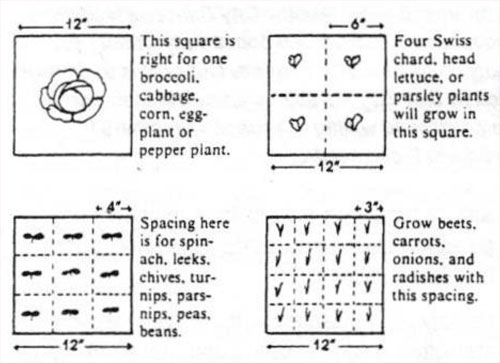

To start with use string or a template made from wire mesh to help with the spacing of seedlings. For seeds that go directly into the soil just place 2 or 3 seeds at the correct spacing and once germinated snip of all but the strongest with a pair of scissors.
Planning Your Plantings
Sitting down with a paper and pencil and working out exactly what your needs are is an important part of square foot gardening. By creating a table it becomes quite a simple matter to work out how much and how frequently you have to plant.
Starting seeds
Methods for planting seeds are many and varied. The main point here is to plant a few seeds at a time but regularly every week or every fortnight according to your needs or the time of the year.
Transplanting
As soon as the seeds are up prick them out into individual containers to allow them to grow into good size plants ready for planting out. At all times aim to have a steady supply of seedlings to go into the garden beds.
Harvesting and replanting
With only a limited number of plants maturing at one time it is easy to harvest the vegetables while they are at their prime. As soon as each square foot becomes vacant prepare it for planting the next crop. At this stage it is advisable to top up the soil with some compost and another helping of mulch.
Square Foot Gardening for a Cash Return
There is little profit for the backyard gardener in growing for the retail market. The competition is too high from the commercial growers and the retailers take too big a slice of the profit. It is much better to sell directly to the consumer who, in. general, will be like you and will want a continuous supply of a variety of vegetables. The transition from growing for your family to growing extra in order to get a small income is therefore just one of scale. Increase the number or length of your four-foot wide beds and plant out a few extra square feet of each vegetable every week.
Conclusions
The main reason why people are interested in organic gardening is because they want fresh, wholesome vegetables as a regular part of their diet. A massive planting of the whole garden in the spring will give you plenty to eat in the summer and some extra to bottle or freeze for the winter but too often the winter garden is neglected and there is little continuity of the crop. This results in most people having to supplement their vegetables from the shops for quiet a number of months. Regular sources of organic vegetables are almost non existent in Canberra at present and so if nothing else is gained from the concept of square foot gardening but the determination to plant a small number of seeds on a regular basis throughout the year (and there are lots of tasty and interesting winter vegetables) you will be guaranteed vegetables year round. By dividing your garden up into small manageable sized plots the workload is in fact reduced—you garden more efficiently. There is an added advantage of continuous planting— continuous attention—plants thrive on it. If you fully encompass the square foot method not only can you feed your family well but also your vegetables can provide a supplement to your income. Organic vegetables, in good condition, are hard to come by; they therefore command premium prices.
References
Square Foot Gardening by M. Bartholomew, Storey Publishing, Vermont
Cash from Square Foot Gardening by M. Bartholomew, Storey Publishing, Vermont
